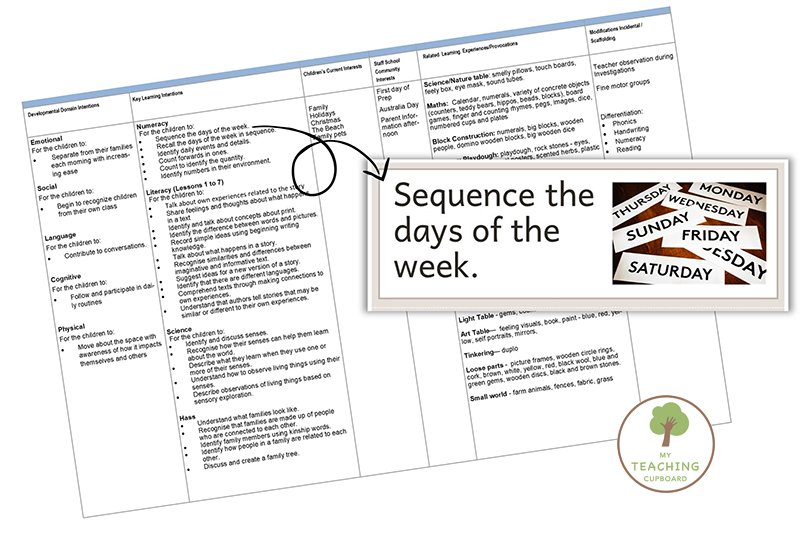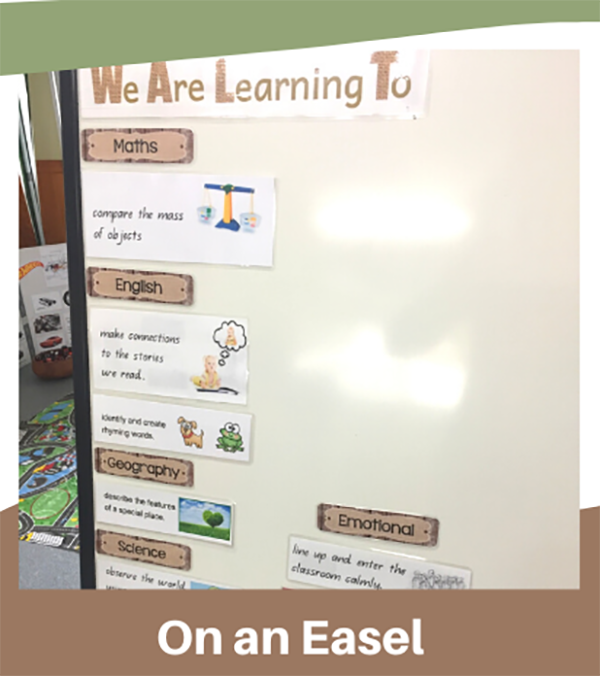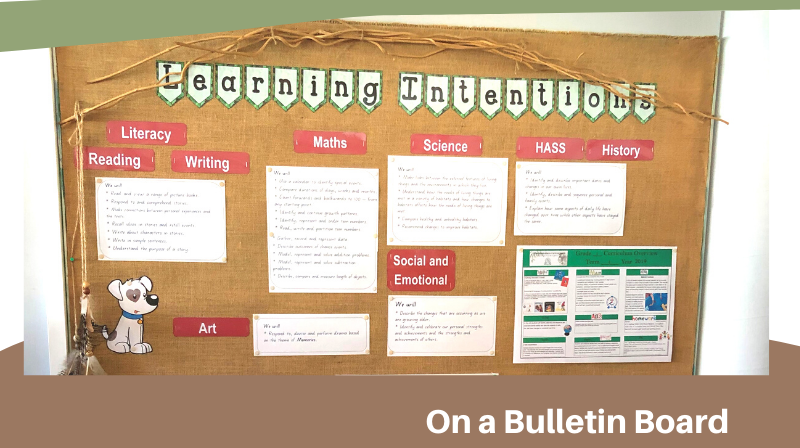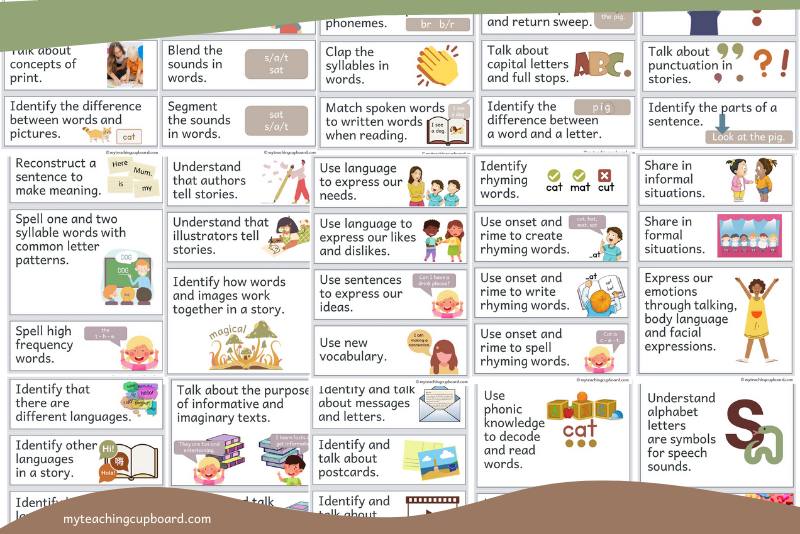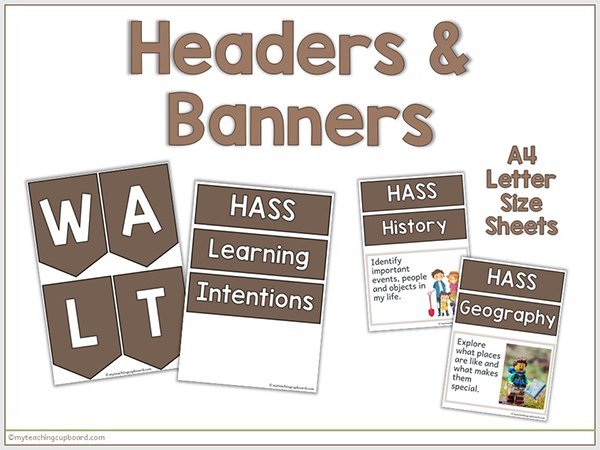Do You Need Learning Intentions and Success Criteria in an Early Years Classroom?
Do you use learning intentions and success criteria in your classroom?
Do you really need them in an early years classroom?
Well, the short answer is yes! The long answer is also yes – but they need to be delivered in an age-appropriate way if you want them to be effective.
In this blog post you will discover exactly what learning intentions are and why they are so important to discuss and display in any early childhood learning environment. I will also share some practical tips and ideas for you to have success using and displaying your classroom learning intentions.
When you use and refer to your class learning intentions and success criteria, it can help you purposefully align your lessons and activities to the curriculum.
Whether you call them WALT goals, learning objectives or curriculum outcomes – they really are all the same things. Learning intentions!
What do you call them?
I prefer to call them learning intentions because it places the emphasis on the process of our intended learning rather than a final piece of work (or assessment piece) or product.
Sometimes I call them WALT goals. WALT is an acronym for We Are Learning To. WALT is very often followed closely by WILF (What I Am Looking For) and TIB (This Is Because). I honestly don’t refer to WLIF and TIB that much in the early years classroom because I found the children just started tuning out whenever I mentioned them.
That does not mean I think WILF and TIB are irrelevant. No – No - No!
I think discussions around what you are looking for, success criteria and why you have a specific learning intention are EXTREMELY important. I just don’t think we need to be labelling every process of the lesson or activity.
It is much more meaningful to have purposeful discussions around learning intentions because you know how important these discussions are rather than a quick mandatory mention of WALT, WILF and TIB because that’s what “good teachers” do.
What are Learning Intentions?
A learning intention needs to be a simple statement. It should be as short as possible and to the point.
Curriculum learning intentions are usually created by the teacher but if you help your children to create their own personalised learning intentions or learning goals, it can be very powerful. Personalised learning goals are so much more effective than teacher created ones.
You might like to check out this blog post: Personalised Writing Goals. In this blog post I explain how you can start setting personalised writing goals with your children. Even the youngest beginner and pre-writers will benefit immensely from personalised learning intentions.
A good learning intention clearly describes what your children need to know, understand, and be able to do. It should focus on what your students are learning and not just be about the lesson task or activity you have planned.
“Learning Intentions are what you want students to know and be able to do by the end of one or more lessons. Without learning intentions and success criteria, lessons wander and students become confused and frustrated.” Douglas Fisher and Nancy Frey
What are Success Criteria?
Success criteria are the measures you use to determine whether, and how well, children have met the learning intentions. The success criteria should be used to inform you and your children if they have achieved the set learning intention.
Success criteria should be linked to your learning intentions. They are also usually created by the teacher and describe what success looks like.
Again, if your children can create their own success criteria or if you can co-create the success criteria together, you will find your children are much more committed to their learning.
Instead of just sharing teacher created success criteria with your children, try to involve them in creating it. Share the pen and co-create actual work samples together and use these as your success criteria. If you can co-create your class success criteria together, your children will be much more likely to take ownership and be invested in their learning.
Why Learning Intentions are Important
Effective learning intentions and purposeful success criteria will improve your children’s learning.
Research indicates that students who regularly discuss and are made aware of their learning intentions and success criteria are more
focused and for longer periods of time.
more motivated and active in their learning.
able to take responsibility for their own learning.
When you display and discuss the learning intentions you will be giving your children the tools they need to take more responsibility for their own learning and achieve greater learning independence.
How to Use Learning Intentions with Young Children
We have no problem including learning intentions and success criteria in our planning documents but often run into difficulty when we have to put these documents into child-friendly terms.
When I first started sharing the curriculum learning intentions with my young learners, I would try to re-word them. This often led to long winded sentences and half expressed goals. It wasn’t long before I gave up trying to use what I thought was “child friendly terms”.
Our young children are quite capable of learning and using new vocabulary and metalanguage. In fact, it makes them feel grown up and vocabulary development is after all one of our major learning goals. Now I just discuss and display the exact same learning intentions that are in my teacher planner and curriculum documents.
Teacher Tip: Teach your children the subject specific metalanguage to develop their vocabulary and improve their comprehension of the learning intentions.
When discussing the learning intentions with your little ones, try to relate them to their prior learning or other content you have been studying.
When I refer to a learning intention at the start of an explicit teaching lesson, I try to relate it to that day’s Tuning-in session or investigations and reflection session. This helps the children to make connections between what they are learning during investigations and the explicit teaching lessons later in the day.
This integration and connection can happen the other way too. I always try to refer to a planned explicit teaching lesson during our learning intention discussions during that day’s tuning-in session.
It is amazing how much more purposeful our investigation sessions and our explicit teaching lessons become when the children can see how all their learning is connected.
It is very important to discuss the learning intentions. I don’t ever just read them out and move on. We discuss them regularly throughout the day.
The learning intentions will become useless if the children do not see their relevance. It is crucial that you discuss each learning intention and have discussions around why particular learning intentions are important to master.
How to Display Your Learning Intentions
Having the learning intentions on permanent display in the classroom is the most effective strategy.
I often include a WALT slide at the beginning of my explicit teaching PowerPoint presentations which outlines the relevant learning intention but I always have them displayed at some type of permanent display too.
However it is ideal to have a permanent classroom display of your learning intentions. A permanent display is the perfect learning reminder your children need to stay on task and focused on their learning.
You can have a dedicated space on your whiteboard …
Display them on a teacher easel …
Or use a bulletin board …
Why Display Your Learning Intentions?
Having the learning intentions on display allows you to easily refer to them and reinforce them
during your morning meeting.
during your tuning-in session.
at investigation reflection time.
at the beginning of explicit teaching lessons.
incidentally throughout the day.
The more you use and refer to the learning intentions, the more your children will too.
In preschool and kindergarten, written learning intentions are somewhat ineffective because young children are just not confident readers yet. When you refer to the written learning intention on display, all your little ones see is a collection of letters.
For this reason, I like to use illustrated learning intentions in my early childhood settings. Learning intentions with a pictorial representation will help your students remember and better understand their WALT goals.
Teacher Tip: Use illustrated learning intentions so each learning intention has a pictorial representation to help your students remember and better understand their goals.
I have spent hours designing a full set of illustrated learning intentions aligned to our ACARA Foundation Stage curriculum. Each learning intention has been carefully linked to the Australian Curriculum and I cannot believe how many of them there are.
409!! That’s over 100 new learning intentions every term!
Do we really expect 4 and 5 year-olds to master 409 learning objectives in their first year of schooling? Compiling this pack of visual learning intentions just reinforced how incredibly jam packed our curriculum is!
If you are interested in saving yourself a lot of time and effort, you might like to check out my pain-staking comprehensive pack.
The pack contains 186 English curriculum learning intentions
It also has 159 Math curriculum learning intentions. All of the learning intentions in this pack have been carefully aligned to the Australian curriculum.
There are 42 Science curriculum learning intentions too. I love how quick and easy it makes setting up a learning display.
And finally 22 HASS curriculum learning intentions. A full set of display banners and headings are also included.
Every curriculum subject deserves and needs carefully designed and age-appropriate learning intentions.
For each investigation area you offer, every learning invitation you design and every lesson you teach, everybody (teachers, parents and students) needs to be clear on what the children need to know and why that is important.
To have successful and purposeful curriculum aligned lessons and activities, the learning intentions need to be your first consideration. Inspiring learning invitations from Instagram or Pinterest should not be your starting point. Start with your learning intentions.
Teacher Tip: Purposefully create and align your lessons and activities to your learning intentions and not the other way around.
Do you need learning intentions and success criteria in an early years classroom?
Yes you most definitely do!!
I hope this blog post has helped you discover some tips and ideas on how to deliver them in an effective age-appropriate way.
If you liked this blog post on Learning Intentions and Success Criteria in an Early Years Classroom and found it valuable, please consider sharing it...
Just CLICK the sharing box below.👇







